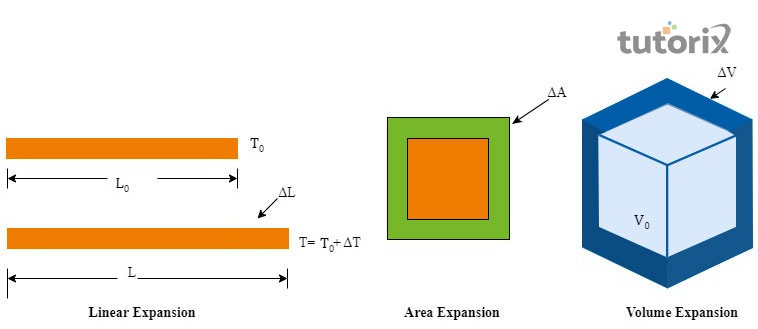

The thermal expansion of solid objects is observed when the temperature increases. The expansion of solid objects at a high temperature refers to as the thermal expansion of solids.
A fractional change in terms of volume and height is seen. For example, it is commonly seen a gap between the railway track just because of the excessive temperature of the sun and the wheel of the trail the thermal expansion can be seen. In general, linear and coefficient expulsion can be seen on solid objects.
On a solid object, the thermal expansion can be seen in terms of length, height as well as thickness but in the case of a liquid object, the thermal expansion can be seen through volume expansion.
The thermal expansion is occurred because of the atomic and molecules movement of a solid object. The direct or indirect application of the bonding forces creates an expansion of the atomic structure of the particles that guide to an increase in the height, length, as well as thickness of a solid body (Ge et al. 2018).
For the crystalline solid particles an isometric, as well as non-isometric expansion, can be happened.

Figure 1: Thermal expansion
The isometric expansion refers to the expansion that uniformly occurs in all the directions while the non-isometric expansion refers to the thermal expansion that is not uniform in terms of all directions of the solids objects.
The characteristic property of the solid objects depends on the compound structure as well as the components (Turcer & Padture, 2018).
The coefficient of the thermal expansion is generally higher in soft materials and comparatively lower in harder materials. The unit of measurement of the thermal expansion in the solid body is "$\mathrm{0 C^{1}\:\:or\:\:K^{-1}}$"
The thermal expansion of the solid body parts is depending on the dimensions and the shape. On the solid objects, three different types of body parts are commonly seen "liner expansion, Area expansion as well as volumetric expansion".
The liner expansion refers to the length expansion of the solid body parts. The area expansion refers to the breadth or length expansion. For example, the application of heat in the square titles also refers to the area expansion.

Figure 2: Thermal expansion types
The volumetric expansion is also referred to as the increment of volume of the solid body is increased (Agne, Anand & Snyder, 2022). For example, when a cube is heated then the width of the cube has been expanded and then all the sides of the cube are equally expanded this can be referred to as the volumetric expansion of the solid objects.
In daily life, there are several examples have been seen of the thermal expansion of solid objects. For example, in summer season, the building of the road has been expanded due to the temperature. In order to avoid the side effect of the thermal expansion on the solid body different types of advanced techniques are applied (Schueller et al. 2018).
For the expansion of the road especially in summer, a gap is seen otherwise after the thermal expansion the road surface is cracked.

Figure 3: Thermal expansion of solid objects (metal ball)
The thermal expansion can also be seen in the making of bridges as well as railway tracks. Another application of the thermal expansion can be seen that is in the telegraph post or the electric post (Schueller et al. 2018).
It is commonly seen that the thermal expansion was mostly seen in the metal body, as they are a good absorber of temperature or heat.
The components of the thermal expansion can be seen with the application of different components like heat and solid body. For the thermal expansion, solid objects refer to any crystallized body like a diamond, stainless steel, iron, concrete and many other metals (Mittal, Gupta & Chaplot, 2018). In a soft solid body like rubber, leather or jelly the heat results in the expansion of volume.
The thermal expansion has mostly seen on the metallic body and mostly liner expansion happens in the metallic body. The thermal expansion is entirely dependent on the surface of the solid body. If the surface of the body is flattened enough then the thermal expansion rate is higher while the solid body has a small surface then the thermal expansion rate is also lower. The thermometer is a perfect example of the thermal expansion of the solid body as in this object the volume of mercury becomes higher with the temperature increment.
Q1. What is the formula of Linear expansion?
Ans. The formula of the linear expansion is $\mathrm{\frac{\Delta l}{l}=\alpha l.\Delta T.}$ In this formula, l denotes the length of the body, $\mathrm{\Delta l}$ refers to the length alternation, $\mathrm{\alpha l}$ stands for linear coefficient expansion and $\mathrm{\Delta T}$ denotes the changes in temperature. This is the most commonly seen thermal expansion in the solid body.
Q2. What is the formula for Area expansion?
Ans. The formula of the area expansion is $\mathrm{\frac{\Delta A}{A}=\alpha A.\Delta T.}$. In this formula, A denotes the area of the solid body, $\mathrm{\Delta A}$ refers to the area alternation, $\mathrm{\alpha A}$ stands for area coefficient expansion and $\mathrm{\Delta T}$ denotes the changes in temperature.
Q3. What is the formula of Volumetric expansion?
Ans. The formula of the volumetric expansion is$\mathrm{\frac{\Delta V}{V}=\alpha V.\Delta T.}$ In this formula, V denotes the volume of the solid body, $\mathrm{\Delta V}$ refers to the volume alternation, $\mathrm{\alpha V}$ stands for volume coefficient expansion and $\mathrm{\Delta T}$ denotes the changes in temperature. It is mainly seen in liquid or gas objects.
Q4. What is called Cubical expansion?
Ans. The cubical expansion refers to as the volumetric expansion because in most cases the volume of the cube is expanded with the thermal temperature. With the application of heat, the thermal expansion of the objects of the cube is increased in terms of volume.